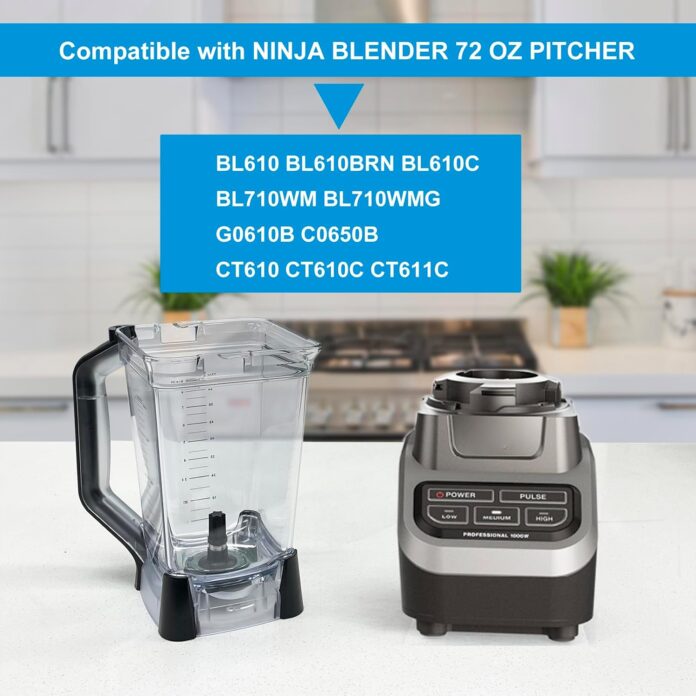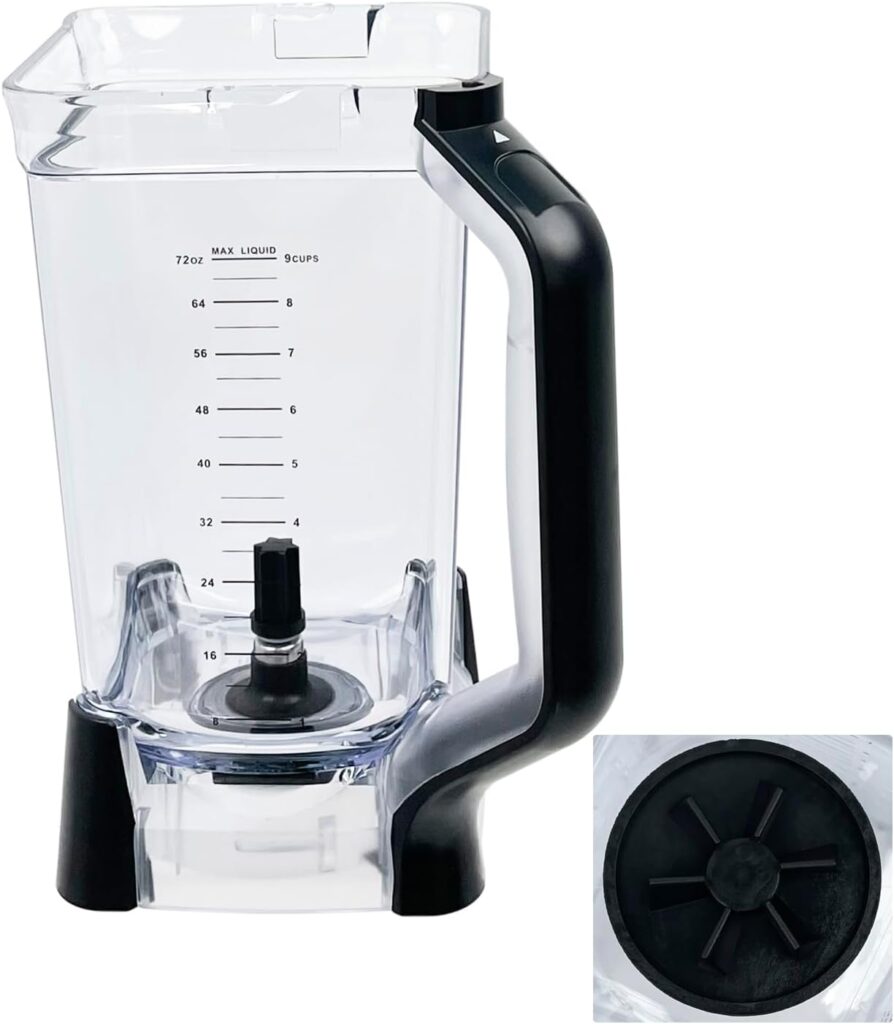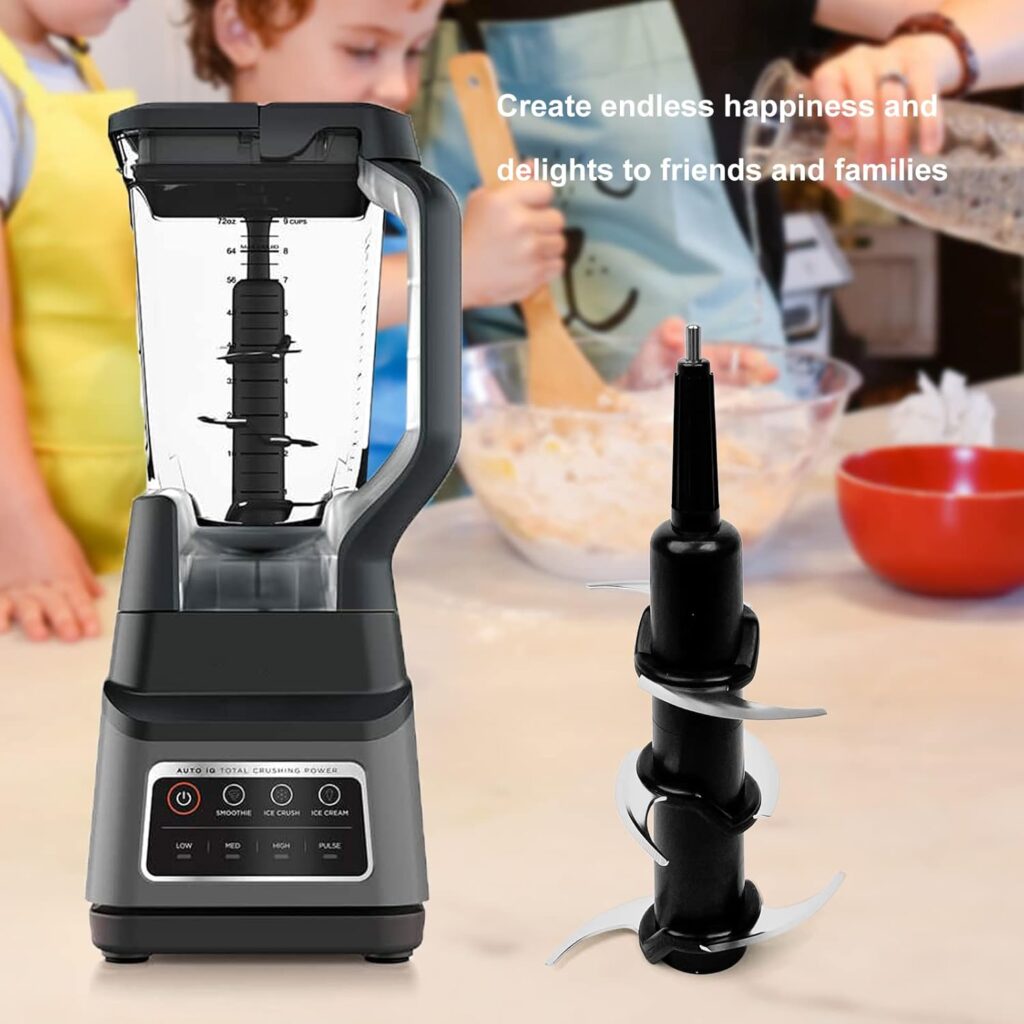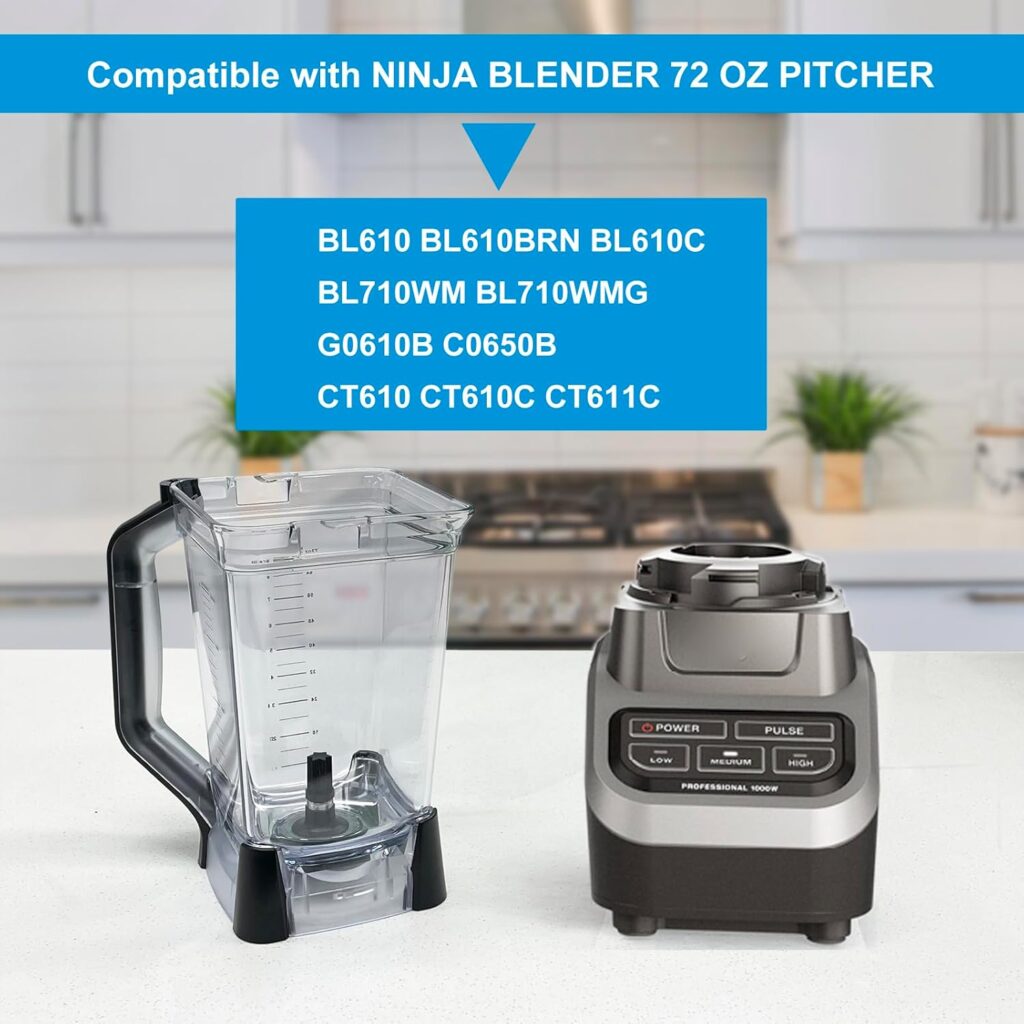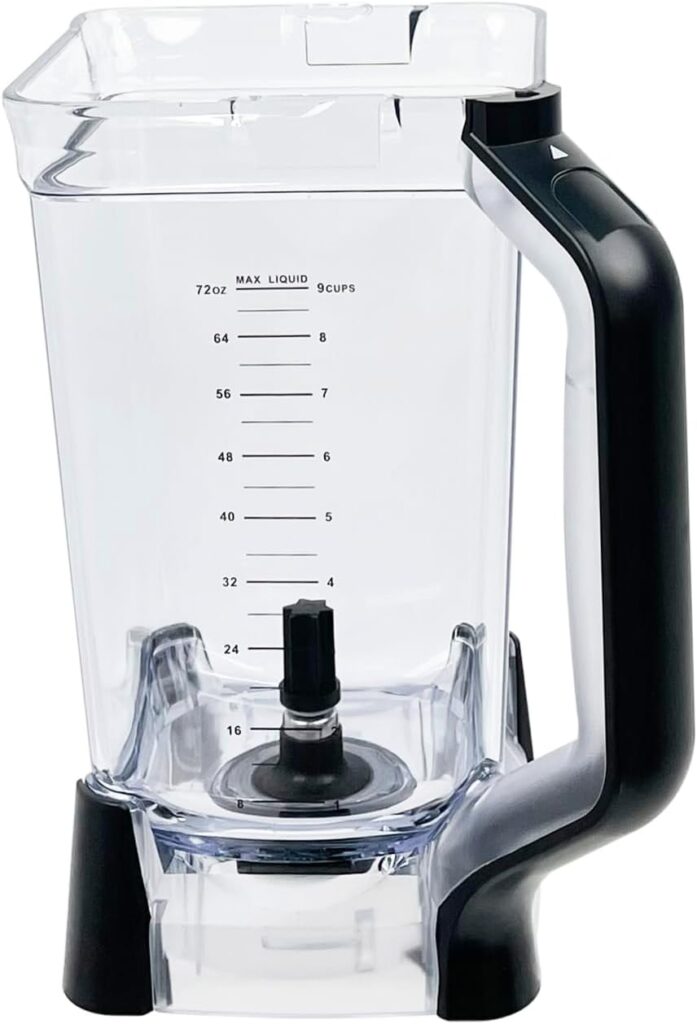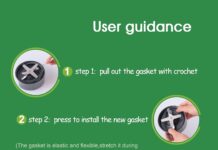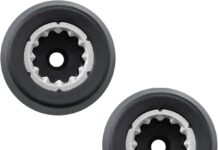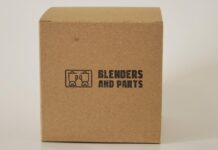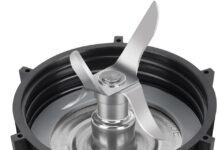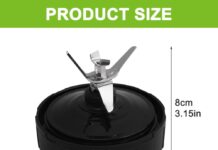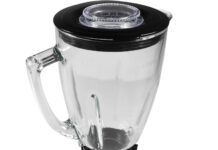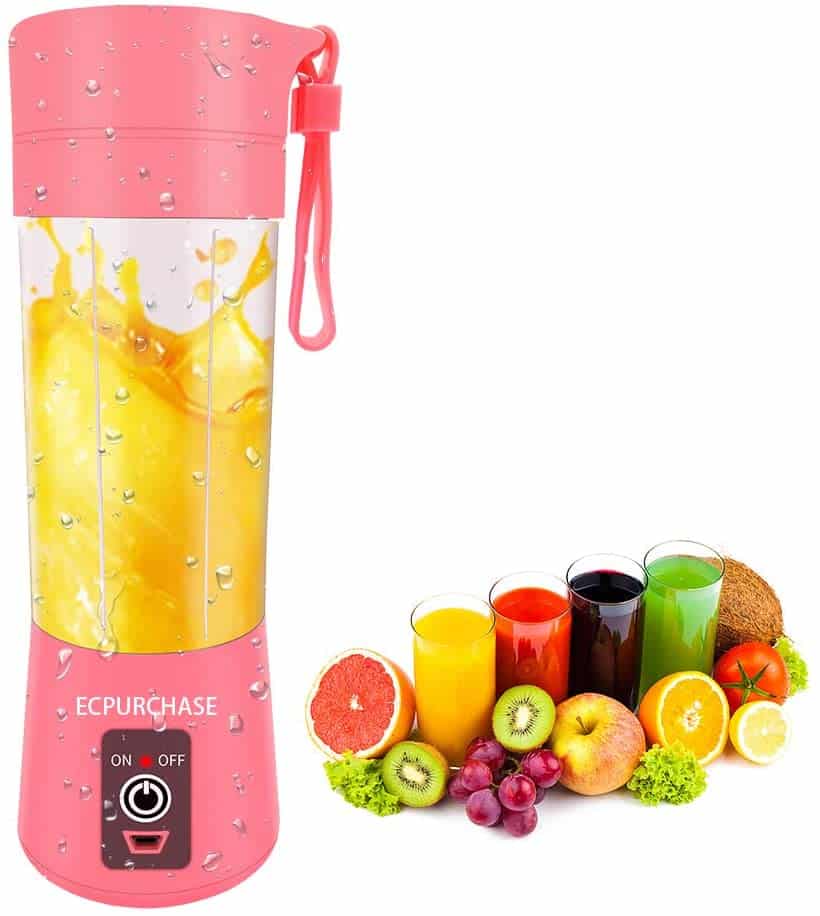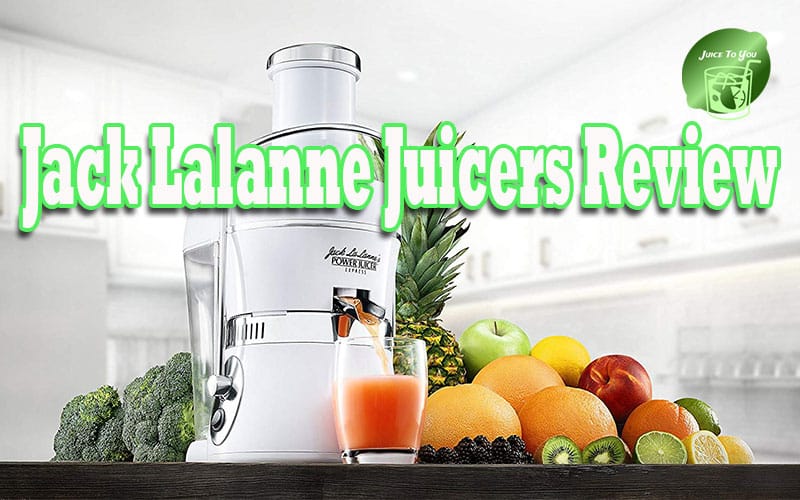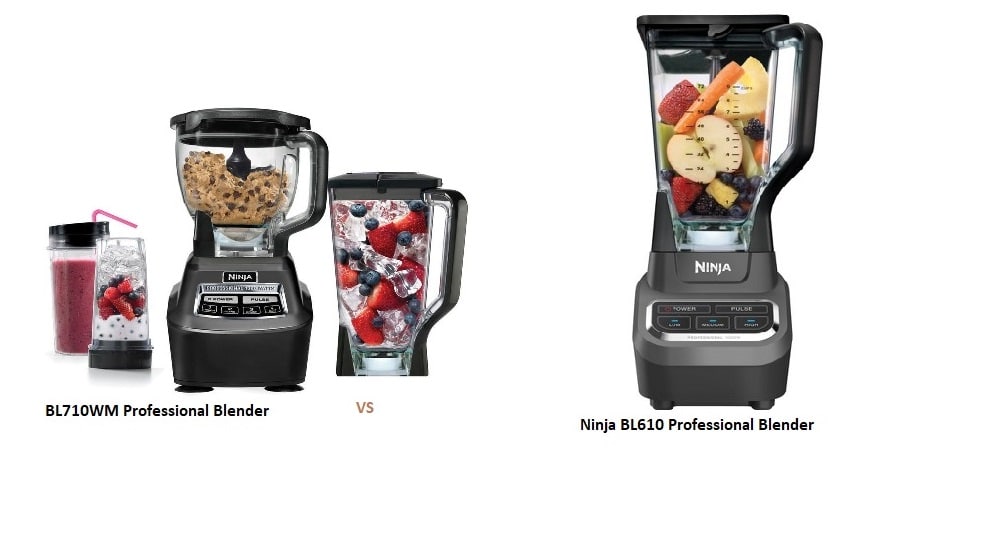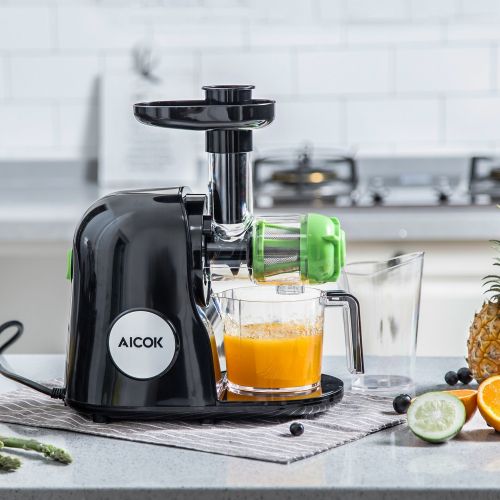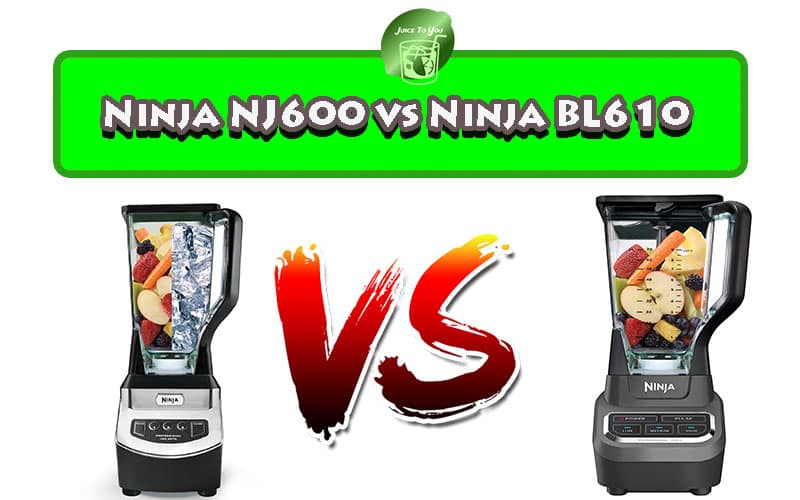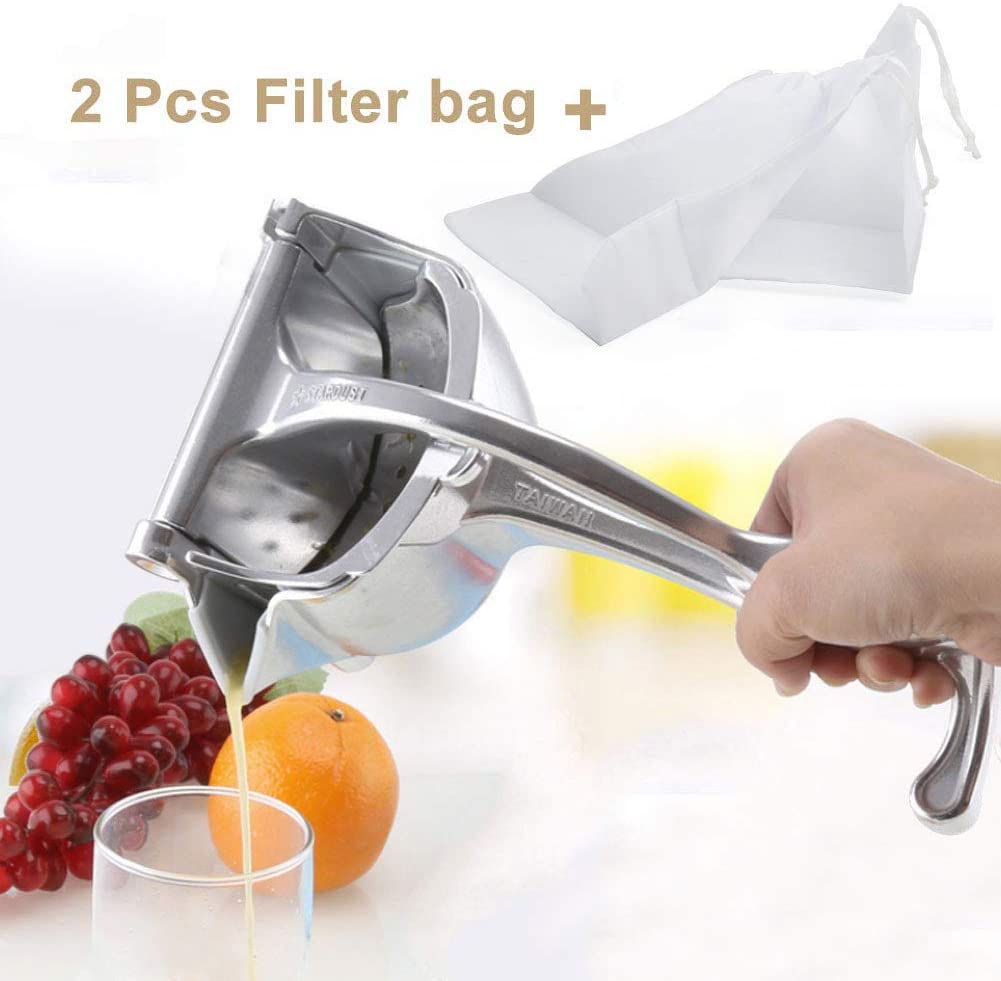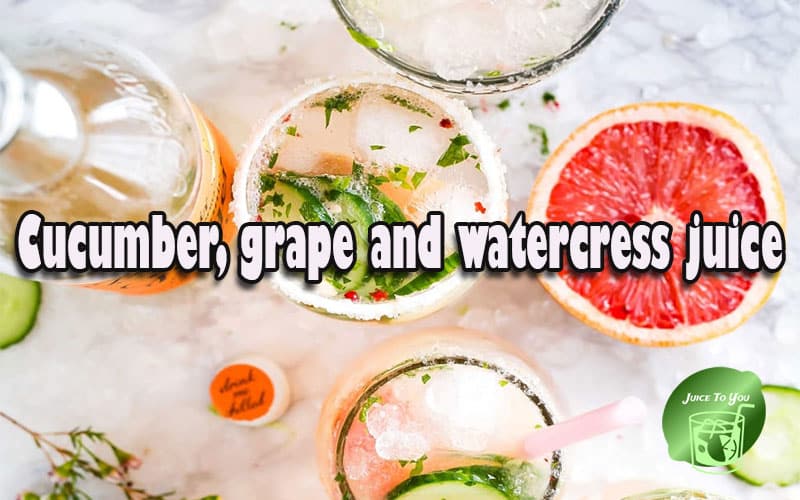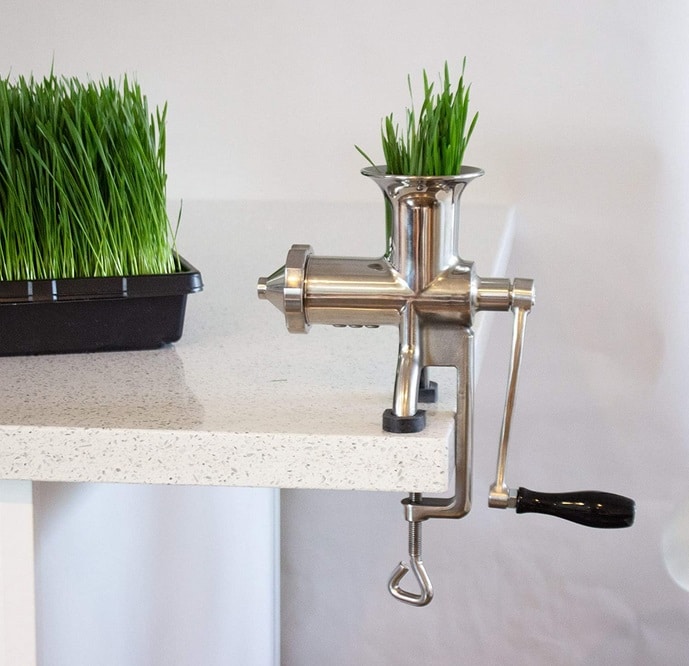? Have we found a practical replacement pitcher that brings our Ninja blender back to life without buying a whole new machine?
Product Overview
We want to give a clear, friendly rundown of what the Blender Parts for Ninja 72 oz (9 Cups) XL Crushing Pitcher BL610 BL710WM BL710WMC CO610B CO650B CT610 is and why someone might consider it. This replacement pitcher is designed to match the look and function of the 72 oz XL crushing pitcher used by specific Ninja blender models, with a few important fit caveats that we highlight below.
We’ll summarize the main selling points and the critical compatibility warnings here so we don’t waste anyone’s time. The manufacturer emphasizes that this is a replacement part — not an original OEM pitcher — and the pitcher will only fit certain newer-style locking lids and bases.
Key Features
We like to start by listing the features that matter to most users so we can compare what we expect versus what we actually get. This pitcher boasts 72 oz capacity (9 cups), BPA-free material, dishwasher-safe construction, an extended rim design, and a raised six-fin base configuration which affects lid fit and locking.
We also want to stress the attention note: it only works with locking lids that have a handle extension and with original pitchers that use the same raised six-fin base. If those two points aren’t both true for our current parts, the fit won’t be correct.
Blender Parts for Ninja 72 oz (9 Cups) XL Crushing Pitcher BL610 BL710WM BL710WMC CO610B CO650B CT610
$71.23 In Stock
Quick Specification Table
We find a table helpful when deciding at a glance whether a replacement part will suit our blender. Below we break down the most relevant specs and warnings so we can quickly check the important fit details.
| Item | Details |
|---|---|
| Product Name | Blender Parts for Ninja 72 oz (9 Cups) XL Crushing Pitcher BL610 BL710WM BL710WMC CO610B CO650B CT610 |
| Capacity | 72 oz / 9 cups |
| Compatibility (general) | Ninja models: BL610, BL610BRN, BL610C, BL710WM, BL710WMG, G0610B, C0650B, CT610, CT610C, CT611C |
| Material | BPA-free plastic (manufacturer claims same materials as original) |
| Lid compatibility | Only locking lids with handle extension (new model lids) |
| Base style | Raised six-fin base with protruding gear fins (new model base) |
| Dishwasher safe | Yes (manufacturer states dishwasher safe) |
| Package contents | One 72 oz pitcher only; locking lid and blade assembly NOT included |
| Warnings | Will NOT fit old-style lids or old pitcher bases; check model and rim/base design carefully before buying |
| Warranty note | Normal wear and tear of wearable parts not covered |
We included the table so we can rapidly check the match between our existing pitcher and this replacement before ordering. The most frequent fit problems come from mismatched rim/lid designs or differences in the base gear configuration, so those are the details we pay closest attention to.
Compatibility and Fit
We want to be absolutely clear about compatibility because buying the wrong pitcher wastes time and money. This replacement is explicitly meant for certain Ninja models only, and the seller stresses “NO EXCEPTION” — meaning we should verify model numbers and visual cues thoroughly before purchase.
When assessing fit, we check two visible features on our existing pitcher: whether the lid’s locking mechanism has a handle extension (the lid handle must extend and engage a protrusion on the pitcher rim), and whether the base of our pitcher has the raised six-fin gear protrusions. If our pitcher or lid lacks either of those characteristics, this replacement will not fit.
Compatible Models (List)
We usually find it helpful to have the exact model numbers all in one place so we can match ours. The seller lists the following compatible models: BL610, BL610BRN, BL610C, BL710WM, BL710WMG, G0610B, C0650B, CT610, CT610C, CT611C. We should confirm our blender model number before ordering.
We also recommend checking any model variant codes printed on the bottom or rear of the base (or in the user manual) to make sure ours exactly matches one of the listed identifiers. If the model number on our machine differs by even a letter or number, cross-checking against photos and the two physical compatibility cues (lid handle extension and six-fin base) will help avoid mistakes.
Important Compatibility Notes (Extended Rim & Six-Fin Base)
We must pay attention to the “extended rim” detail because it’s a design change in the newer pitchers; the rim sits slightly differently so only lids with a handle extension will lock properly. If our lid is the older flat or recessed style without an extended handle engagement, it will not lock securely on this replacement pitcher.
Equally important is the raised six-fin base: the replacement’s outer base uses six protruding fins that engage certain blade assembly hubs and/or the blender base. If our original pitcher base is smooth or uses fewer/more protrusions, the fit will be incompatible. These two points combined are the decisive compatibility test.
Build Quality and Materials
We care about safety and durability, so material composition matters to us. The seller states the pitcher uses the same materials as the original Ninja part and is BPA-free and dishwasher safe. That means it’s intended for everyday kitchen use and is safe for food contact.
We also consider thickness, flexibility, and odor retention when assessing a plastic pitcher’s longevity. While the seller’s claim suggests OEM-quality materials, we find it helpful to inspect the pitcher upon receipt for mold lines, material thickness near the lip and handle, and whether the plastic has any faint chemical odor that might affect flavor.
BPA-Free and Food Safety
We consistently prioritize BPA-free plastics for blending tasks that involve hot liquids or prolonged storage. This replacement is labeled BPA-free, which aligns with our preference for safer food-contact plastics.
We’ll still rinse and air out the pitcher before first use, and for any initial chemical smell we’ll run a quick warm-water-and-baking-soda soak to remove factory residues. Doing that helps ensure the pitcher is taste- and odor-neutral before we prepare smoothies, soups, or baby food.
Dishwasher Safety and Cleaning Considerations
Dishwasher safe is convenient, but we often recommend a moderate approach: while parts may be dishwasher-safe, repeated high-heat cycles can accelerate wear over months or years. We prefer placing plastic pitcher pieces on the top rack and using gentle cycles to extend life.
If we want to preserve clarity and prevent micro-scratches, periodic handwashing with a soft brush and mild detergent is a sensible alternative. That’s especially true if we frequently blend hard particles (ice, frozen fruit) that can cause abrasion inside the pitcher.
Design and Practicality
We look at design from the perspective of daily use: ergonomics, pourability, stability, and whether the pitcher integrates smoothly with our existing base and lid. The extended rim design helps certain lids lock securely, while the wide 72 oz mouth makes adding ingredients easy.
The handle and pouring lip are important for controlling messy blends and for serving. We evaluate whether the handle is comfortable to grip when the pitcher is full, whether the lip pours cleanly without drips, and whether the pitcher’s shape fits under most kitchen cabinets when stored.
Handle, Lip, and Pouring Performance
We want a handle that balances the pitcher easily even when it’s full of heavy ingredients like frozen fruit and ice. A secure grip reduces the chance of spills when transferring contents or attaching the lid for blending.
A well-formed pouring lip prevents drips and makes transferring soups, smoothies, and batched beverages simpler. If we notice any sharp seams or an uneven lip edge, we’ll sand or smooth it carefully before using to avoid accidental dribbling or splashes.
Stability and Base Engagement
Stability matters because an ill-fitting pitcher can wobble on the base, creating noise or poor blade engagement. The raised six-fin base is intended to match specific base and blade assemblies to provide solid engagement during operation.
We recommend checking how the pitcher aligns with the blender base and blade housing before starting the machine. If the pitcher doesn’t sit flush or the blade hub feels loose, we stop and reassess to avoid damage or motor strain.
Installation and Use
We like clear, step-by-step installation guidance so we don’t risk damaging the pitcher, lid, or base. The key points are: verify lid compatibility, ensure the blade assembly fits the raised six-fin base if applicable, and confirm that the pitcher aligns on the base securely before starting.
Because the package contains the pitcher only, we need to reuse our original locking lid and blade assembly (if compatible) or acquire compatible replacements. If our lid or blade is incompatible, operating the blender without correct locking could be dangerous.
Step-by-Step Installation Guide
- Verify that our locking lid has a handle extension that will mate with the pitcher’s extended rim. If not, do not proceed.
- Inspect our blade assembly and blade hub to ensure it matches the raised six-fin base engagement. If the blade doesn’t thread or sit correctly, stop and compare parts.
- Place the pitcher on the blender base, rotating and lowering it to feel secure and seated. If it wobbles, don’t run the blender until fit is corrected.
- Insert the blade assembly (if removed) into the pitcher base per blender instructions, making sure seals and gaskets are present and undamaged.
- Place the locking lid with handle extension on the extended rim, engage the handle into the lock, and confirm a firm seal before powering the blender.
We recommend going through these steps carefully the first time so we can be confident about fit and safe operation.
What’s Not Included and What That Means for Us
The seller notes that only the pitcher is in the package and that the locking lid is not included. That means we must reuse our existing lid and blade assembly or purchase compatible parts separately.
If our original lid is the old style without a handle extension or our blade hub doesn’t match the six-fin base, we will need to either find a compatible lid/blade or choose a different replacement pitcher that matches our existing parts.
Cleaning and Maintenance
We prefer simple maintenance routines that keep parts sanitary and functional. The manufacturer states that the pitcher is dishwasher safe, which makes cleanup straightforward, but we’ll balance convenience with long-term care by occasionally handwashing and checking seals and gaskets.
Regular visual inspection of the pitcher for scratches, cracks, or clouding helps us catch wear early. Any hairline cracks around the rim or base are red flags and suggest replacement to avoid leaks or safety issues.
Routine Cleaning Tips
We suggest rinsing immediately after use to prevent residue from hardening, then using warm, soapy water and a soft brush to clean thoroughly. If using the dishwasher, place the pitcher on the top rack and avoid high-heat sanitize cycles to minimize plastic degradation.
For odor removal, a paste of baking soda and warm water left for 15–30 minutes often does the trick. For stubborn stains, a diluted white vinegar soak followed by a rinse and air-dry can help restore clarity.
Long-Term Care and Storage
Store the pitcher with the lid off to allow airflow and prevent odors. Keep it away from direct sunlight and heat sources to prevent warping. If we won’t use the pitcher for a long time, a light coating of vegetable oil on seals can prevent gaskets from drying out, but ensure we wipe it clean before next use.
Performance and Practical Use Cases
We are often interested in how well a replacement pitcher performs compared to the original. When properly matched to compatible lids and blade assemblies, this pitcher should offer the same capacity and functional performance for smoothies, frozen drinks, sauces, and batched liquids.
Because performance depends heavily on blade compatibility and base engagement, we stress that proper fit is essential. When fit is correct, the motor couples to the blade assembly as designed and the pitcher can handle typical Ninja tasks including crushing ice and blending frozen ingredients.
Smoothies, Frozen Drinks, and Ice Crushing
We usually test pitchers with frozen fruit and ice to assess sturdiness. If the blade engages securely and the pitcher is stable, it will manage ice and dense blends similarly to the original pitcher; however, repeated heavy ice use can accelerate wear compared to lighter tasks.
If we primarily make green smoothies or delicate sauces, this pitcher will be more than adequate. For very frequent, heavy-duty ice crushing we recommend inspecting the pitcher regularly for stress marks and considering an OEM part if we want maximum longevity.
Hot Liquids and Soup Making
The manufacturer doesn’t explicitly forbid hot liquids, but we advise caution. Rapid temperature changes can stress plastic, so we recommend allowing very hot ingredients to cool slightly before blending or using a blade assembly rated by the manufacturer for hot blends.
We also remind ourselves to ensure seals are intact before processing hot liquids to prevent steam pressure from escaping unpredictably through weak points.
Value and Cost Savings
We appreciate that buying a replacement pitcher can be a practical way to extend the life of an otherwise functional blender base. This replacement is significantly less expensive than buying a whole new blender, and it’s often a good value for users whose base and motor are in good working order.
That said, we should balance initial cost savings against potential long-term durability. If our existing blades or lid are worn, it may be economical to replace multiple parts at once or to invest in OEM components if we want the best match and longevity.
When a Replacement Pitcher Makes Financial Sense
If our blender motor is working fine and only the pitcher cracked or became unusable, replacing the pitcher is almost always the smarter financial move. It minimizes waste and returns the blender to service quickly.
We should also factor in potential additional expenses, such as purchasing a compatible lid or blade if ours are not compatible. If multiple parts need replacement, compare the combined cost against buying a new appliance.
Warranty and Wear Considerations
The seller notes that normal wear and tear of wearable parts like blending vessels is not covered by warranty. That means we take on the risk of wear-related failure after purchase.
We recommend keeping evidence of purchase and inspecting parts before use so we can document early defects, but we should not expect long-term warranty protection for items that are subject to regular friction and stress.
Pros and Cons
We like having a clear pros-and-cons list to summarize the strengths and limitations we’ve observed. This helps us quickly decide whether this particular replacement suits our needs.
The pros include cost savings, BPA-free materials, dishwasher convenience, and full 72 oz capacity. The cons center on strict compatibility requirements, the fact that only the pitcher is included (no lid or blades), and potential durability questions compared with OEM parts.
Pros
- Cost-effective way to replace a broken pitcher and extend blender life.
- BPA-free material and dishwasher-safe construction make cleanup straightforward.
- Full 72 oz (9 cup) capacity maintains the original XL functionality for batching.
- Extended rim and six-fin base match newer Ninja design if our parts are compatible.
We find these pros compelling when our blender base and blades are in good condition and only the pitcher needs replacement.
Cons
- Very strict compatibility: only works with specific Ninja models and new-style lids with handle extensions.
- Package includes only the pitcher; locking lid and blade assembly are not included.
- If our original pitcher base or lid is the older style, we may need to purchase additional parts or return the item.
- Possible differences in long-term durability compared to original OEM parts.
We weigh these cons carefully, especially compatibility warnings, before deciding to purchase.
Troubleshooting and Tips
We like to prepare for common issues so we don’t get frustrated after ordering. If the pitcher doesn’t fit our lid or the blade doesn’t engage, most problems are due to base or lid mismatches; this guide will help us diagnose and remedy common scenarios.
We recommend visually comparing our existing pitcher and lid to the product photos and checking for the extended rim and raised six-fin base before purchasing. If we’ve already bought a pitcher that doesn’t fit, refer to the returns policy and seller notes for next steps.
Common Problem: Lid Won’t Lock
If the lid won’t lock, check whether the lid has a handle extension that reaches over the extended rim. If the lid is an older, flat design, it won’t engage the newer rim. In that case we need to locate a compatible lid with a handle extension or return the pitcher.
We also make sure any latch or hinge on the lid is not warped or broken. Sometimes debris or sticky residue prevents proper engagement; cleaning around the lid latch and rim often resolves minor sticking problems.
Common Problem: Pitcher Wobbles on Base or Blade Doesn’t Spin
A wobbly pitcher usually indicates that the raised six-fin base geometry doesn’t match the blade hub or motor coupling. If the blade assembly doesn’t seat correctly, do not run the blender. We recommend comparing the base fins and blade hub shape — if they differ, the parts are incompatible and should not be forced.
If the blade assembly looks correct but still wobbles, inspect for worn or missing gaskets, or check that the blade assembly is threaded and tightened properly. Replacing a damaged gasket can sometimes restore safe operation.
Return, Replace, or Keep?
If the pitcher fails our compatibility checks and can’t be used safely, check the seller’s return policy promptly. If returns are not convenient, consider selling or donating the pitcher to someone with a compatible lid/base, but only after verifying compatibility.
If the pitcher fits but shows cosmetic defects that don’t affect function, we may keep it if the price was low and function is intact. Always document defects with photos and contact the seller if we believe the item arrived damaged.
Frequently Asked Questions (FAQ)
We’ve compiled a list of FAQs we frequently hear when considering replacement blender pitchers, along with clear answers so we can make informed decisions.
Q: Does the package include the locking lid and blade assembly?
A: No. The package contains only one 72 oz pitcher. The locking lid and blade assembly are not included, so we must reuse compatible originals or purchase them separately.
Q: Will this pitcher fit older Ninja lids?
A: No. This pitcher is the new model with an extended rim and only fits locking lids that have a handle extension. Older lids without the handle extension will not lock properly.
Q: How do we know if our original pitcher has the raised six-fin base?
A: Turn your original pitcher over and look at the outer base area. If you see six protruding fins or gear-like protrusions on the bottom, it likely matches the replacement design. If the base is smooth or configured differently, the replacement will not be compatible.
Q: Is the pitcher dishwasher safe?
A: The seller states it is dishwasher safe. For best long-term care we recommend the top rack and gentle cycles, or handwashing for extended durability.
Q: Is this an original Ninja OEM part?
A: The seller states this is a replacement part and does not claim to be an original OEM product. It’s intended to be compatible with certain Ninja models but isn’t marketed as an OEM replacement.
Q: What should we do if the lid doesn’t seal or the pitcher leaks?
A: Stop using the pitcher, check for cracks, ensure gaskets and seals are present and undamaged, and confirm lid compatibility. If the leak is caused by a cracked rim or misfit, don’t operate the blender until it’s corrected.
Q: Can we blend hot liquids in this pitcher?
A: Use caution with hot liquids. Rapid temperature changes can stress plastic and seals, so allow hot ingredients to cool somewhat and ensure seals are intact before blending.
Q: What if we’re unsure about model compatibility?
A: Verify the model number on your blender base and visually confirm the extended rim and six-fin base match. If uncertain, contact the seller with clear photos of your existing pitcher and lid before ordering.
Q: Will using the wrong pitcher damage our blender motor?
A: Forcing an incompatible pitcher or blade assembly could cause misalignment or extra load on the motor. If the pitcher doesn’t seat properly or the blade feels unbalanced, do not run the blender.
Q: How can we reduce odors or stains in the pitcher?
A: Use a baking soda paste or diluted white vinegar soak, followed by thorough rinsing and air drying to remove lingering smells or stains.
Comparison with OEM and Other Replacements
We want to compare this replacement pitcher to OEM parts and other aftermarket options to understand relative strengths. Compared to OEM parts, aftermarket replacements are often less expensive and may use similar materials, but they can vary in tolerances, finish quality, and long-term durability.
Against lower-cost generic pitchers, this product’s clear compatibility notes and design cues (extended rim, six-fin base) may better match some Ninja models. Nonetheless, choosing an OEM replacement where available provides the best assurance of exact fit and longevity.
OEM vs This Replacement
OEM pitchers are produced by the original manufacturer and typically guarantee a perfect fit and consistent materials. This replacement claims to use the same materials and mimics the newer design, but since it’s not OEM it may lack certain quality controls or long-term durability assurances.
If our goal is maximum reliability and long service life and cost is less of an issue, we might prefer the OEM part. If cost-effectiveness and quick replacement are higher priorities, this aftermarket pitcher could be the right balance.
Aftermarket Alternatives
Other aftermarket options may advertise broader compatibility or slightly different designs. We recommend comparing photos and physical design details — particularly rim style and base fin configuration — before choosing. Price alone should not be the deciding factor; compatibility and user reviews matter greatly.
Real-World Scenarios and Use Cases
We find it helpful to think through typical user scenarios to determine whether this pitcher meets specific needs. Here are a few common use cases and how the replacement performs in each:
Scenario 1 — Broken Pitcher, Functional Base: If our pitcher cracked but our blender base and blade are fine, this replacement is a practical and economical solution. We get a full 72 oz capacity and can continue making smoothies and batch recipes without buying a new blender.
Scenario 2 — Old Lids and Parts: If we have older lids without handle extensions or an older-style base, this pitcher will not fit. We should instead look for a replacement matching our original rim/base design or consider buying a compatible lid/blade set.
Scenario 3 — Heavy Ice Users: If we crush ice daily for cocktails or frozen desserts, we’ll want to inspect the replacement frequently for wear. If we see stress marks or cracks developing, we may prefer OEM parts for greater durability.
Scenario 4 — Occasional Use for Soups and Smoothies: For users who blend occasionally for soups, smoothies, or purees, this replacement pitcher provides great value and practical performance, assuming compatibility checks are satisfied.
Final Verdict
We’ve weighed the pros, cons, and practical considerations, and we find this replacement pitcher to be a solid, cost-effective option for the right user. If our Ninja blender model is one of the listed compatibles and our original lid and base match the newer extended rim and raised six-fin base, we can expect functional parity for everyday blending tasks.
We advise caution: double-check model numbers and physical cues (lid handle extension and six-fin base). If those checks pass, this pitcher can save us money and get our blender back into regular service quickly. If not, seek a replacement that matches our original design or consider OEM parts for guaranteed fit and longevity.
Disclosure: As an Amazon Associate, I earn from qualifying purchases.

